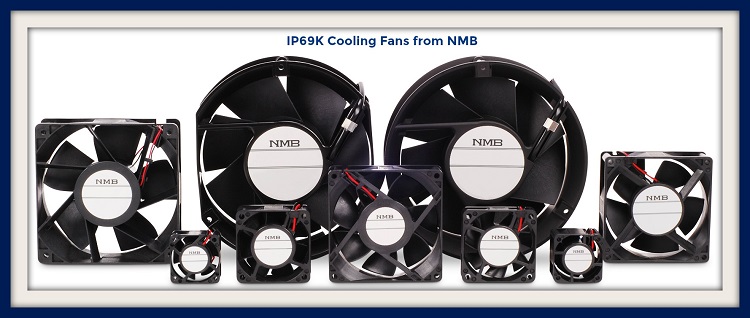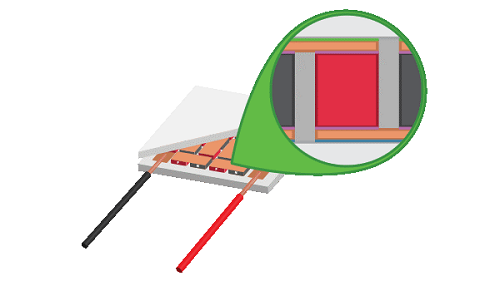By Spencer Chin, contributing writer
With today’s electronics continuing to shrink in size and move toward higher operating frequencies, controlling temperatures at board levels and inside electronic enclosures remains a key challenge facing design engineers. Engineers continue to rely on established cooling devices — fans, heat sinks, heat exchangers, cooling modules — to maintain component ambient and junction temperatures at manageable levels. But innovation in the design of traditional cooling devices is helping offset the growing thermal density.
Ideally, design engineers want to free as much space as possible on boards and in electronic enclosures for processing and control electronics. But newer parts such as high-speed microprocessors and FPGAs tend to generate higher amounts of heat. As ambient air flowing is, by itself, often inadequate to produce the required heat dissipation, design engineers find that they need to add auxiliary cooling devices — despite their added space and complexity — to achieve the necessary reduction in operating temperatures.
Cooling fans are a proven method to thermal management, and fan makers have responded to rising thermal densities with fans that, in some cases, are smaller than their predecessors but are designed more efficiently to move large volumes of air.
The electronically commutated (EC) fans from Orion Fans (Dallas), for instance, provide standard fan speeds of 1,400 and 2,200 rpm with airflow values of 300 and 480 cfm. The thermally protected, brushless DC fans operate from –25°C to 50°C. The electronic commutation allows these DC fans to run on AC, offering 115- and 230-Vac versions, to cool large, power-hungry equipment.
Fans are often called upon to operate in harsh environments as well. For example, Japan-based NMB Technologies Corporation has introduced a fan with an IP69K rating, which protects against ingress of dust and high-temperature, high-pressure water. Products with this certification are ideal for use in applications in which equipment must be carefully sanitized using scalding, high-pressure scrubbing.
NMB’s IP69K fans are available in 12, 24, and 48 Vdc, with air flow from 8 to 346 cfm. Sizes available include 40, 60, 92, 120, 150, and 175 mm. The fans come in a high-reliability metal case and offer a life expectancy of 100,000 hours at 25°C.

Fig. 1: NMB Technologies’ IP69 fans are protected against dust and high-temperature, high-pressure water.
Thermoelectric (Peltier) modules, solid-state devices that convert an electric current into a temperature gradient, provide another active approach to controlling board and enclosure temperatures. Peltier modules consist of two sides — a hot side and a cold side. The module acts as a heat pump in that it moves heat from the cold side to the hot side. TECs enhance your cooling ability by creating a temperature differential that can be more easily moved out of the system.
To improve this approach, CUI’s Thermal Management Group (Tualatin, Oregon) announced a line of high-performance Peltier modules that employ a proprietary arcTEC structure. This construction employs thermally conductive resin between the ceramic and copper on the module’s cold side, as well as using high-temperature solder and larger P/N elements made from premium silicon ingots. The resin layer’s elasticity allows for thermal expansion and contraction during the repeated heating and cooling of normal operation, which reduces mechanical stress on the elements. The reduced stress, in turn, results in a better thermal connection, superior mechanical bond, and no marked drop-off in performance over time. The high-temperature solder and larger silicon elements are incorporated to enable faster and more uniform cooling.

Fig. 2: CUI’s high-performance Peltier modules that employ a proprietary arcTEC structure that combines thermally conductive resin between the ceramic and copper on the cold side of the module. The elastic resin layer allows for thermal expansion and contraction during the repeated heating and cooling of normal operation.
CUI’s CP20H, CP30H, CP39H, CP60H, and CP85H series all employ the arcTEC structure and range in size from 15 to 40 mm, with heights as low as 3.1 mm. These thermoelectric modules are available with a ΔTmax of 77°C (Th=50°C) and current ratings ranging from 2.0 A to 8.5 A. These coolers are suited for high-density, high-power medical and industrial applications as well as refrigeration and sealed environments in which forced air cooling is not an option.
As an alternative to air, design engineers are also looking at liquid cooling. While liquid cooling has mainly been used in products such as supercomputers, the technology is now being considered for heavy-duty cooling in medical, automotive, aerospace, medical, semiconductor processing, and HVAC applications.
Recently, Advanced Thermal Solutions, Inc. (Norwood, Massachusetts) announced a line of tube-to-fin, liquid-to-air heat exchangers made with high-density fins to maximize heat transfer from liquid to air. The design allows the liquid to be cooled to lower temperatures than other heat exchangers on the market. The heat exchanger fins and tubes are made of copper and stainless steel to be suitable for a variety of fluids, including water, dielectric fluids, and custom-designed heat transfer fluids. The heat exchangers have heat transfer capacities up to 250 W per 1°C difference between the inlet liquid and the inlet air temperatures.

Fig. 3: Advanced Thermal Solutions’ ATS heat exchangers employ high-density fans to maximize heat transfer from liquid to air.
But for most board-level designs, heat sinks remain the preferred method to provide localized cooling wherever heat generation is a concern. Such sinks are also evolving to address specific sources. For power resistors, for instance, Ohmite expanded its line of W Series heat sinks, with new sizes available for TO-220 and TO-247 power resistors or similarly packaged semiconductors. The self-aligning Ohmite W series heat sinks feature solderable feet for through-hole placement, and an integrated clip provides 1.32 lbs. of force on the center of the resistor to enhance thermal performance while reducing parts count and assembly time.
CUI’s Thermal Management Group has also added a line of aluminum heat sinks, available in both extruded and stamped versions, for TO-218, TO-220, TO-252, and TO-263 transistor packages. The extruded and stamped heat sinks offer tin-plated or black anodized material finishes and are available with or without solder pins in vertical or horizontal orientations. Thermal resistances measured at 75°C ΔT in natural convection environments are as low as 4.49°C/W, while power dissipation ratings measure up to 16.7 W at 75°C ΔT in natural convection.
Achieving a reliable, consistent heat transfer path between the component and the heat sink’s thermal transfer surface requires thermally conductive materials, which are also seeing innovations. Creative Materials, Inc. (Ayers, Massachusetts), for instance, recently introduced 127-31, an extremely flexible one-component thermally conductive epoxy adhesive. This 100% solids epoxy adhesive, encapsulant, and potting compound is electrically insulating, with a thermal conductivity of 3.0 W/mK. 127-31 features thermal stability up to 325°C and excellent chemical resistance. Unlike conventional epoxy systems, the flexibility of 127-31 can absorb stress when bonding substrates with mismatched CTE (coefficient of thermal expansion). Typical applications include printed circuit board fabrication, power management, advanced materials composites, LED attachment, and heat sink bonding.
In another thermally conductive material type, DuPont Electronic Materials launched in November a portfolio of thermal solutions under the brand Temprion. The Temprion portfolio is completely non-silicone and currently includes thermal greases, thermal gap fillers, electrically insulating films, and adhesive thermal tapes. Applications such as handheld devices, computers, car batteries, and high-power electronic motors in which heat dissipation is a major concern can use Temprion to improve performance.
Whether it be a fan, blower, or heat sink, though, choosing the correct cooling device requires knowledge of airflow requirements, board layout, and ambient temperatures. To help out developers, a number of companies have introduced simulation and modeling software to characterize a design’s thermal environment and help determine cooling needs.
One of the latest tools is AavidGenie, a web tool that enables developers — even those with limited experience — to design effective, manufacturable, custom heat sinks within minutes. The online tool is a thermal modeling application that can be used as often as needed on a pay-per-simulation basis, with a three-use free trial available. The tool provides users with reports, drawings, and models on demand, and designers can request prototype or production samples of their custom heat sink from Aavid.
To learn more about thermal management, check out these other products and stories from around the AspenCore network:
Thermal Analysis of PCB-Mounted Small Outline Packages — How thermal analysis tools can be used for testing and evaluating the small outline packages found on reduced-sized PCBs in modern consumer devices.
How graphene can be used in modern electronics — Graphene has shown to be superior for both active and passive cooling techniques.
Low-cost fan control solution using the Z8F04 — Application note.
Thermal analysis and junction temperature rise in multi-chip modules — Application note.
CUI introduces high-performance DC fan line to bolster thermal management portfolio — Product introduction.
Source Guide: Cooling Devices 2015 — From the EP Power Supplement, a comprehensive listing of cooling product providers.
Advertisement
Learn more about Electronic Products Magazine





